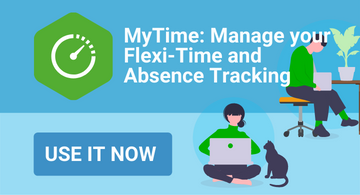Until very recently, most organisations have required their employees to work from 9-5 in an office and productivity has been assessed by noting who was in the office and how long for. However, in the last few years we have experienced a shift in the way we look at productivity - with flexi-time and working from home measuring hours in the office is much less relevant.
This article sets out to discuss and explain why this shift is long overdue and how MyTime will help you manage this... Use the links below if you would like to jump to a specific section:
- I need a nap! Unproductive version
- No butts
- What a day! Unproductive version
- I'm free!
- Whose time is it anyway?
- So, how does MyTime help?
- Won’t people say they are available for work when really they aren’t?
- I need a nap! Productive version
- What a day! Productive version
I Need a Nap! Unproductive Version
Millions of times per week, in offices across the planet, some variant of the following scenario plays out:
It’s 14:45. I took lunch at 12:30.
I’m feeling tired.
I’m at work in the office.
I am staring at my screen, unable to think or write clearly, and finding it difficult to concentrate. My mind is foggy. I feel like I am going to fall asleep. I get up, walk around, splash some cold water on my face, head back to my desk and try to give it the best I’ve got.
A couple of hours go by, I really haven’t achieved very much at all since lunch.
I revert to moving emails from my Inbox into their correct sub-folders. It doesn’t take a lot of brain power, and it can kill an hour before home time.
I feel a bit guilty that the afternoon was not very productive, so I work late until 18:30. By the time I get home, it’s 19:30.
I’m exhausted from a long hard day at work, and I have that deflated sense that there really isn’t much to show for all my effort.
No Butts
At its very simplest, the relationship between employer and employee is one of time and activity control. The employee willingly cedes control over what they do while they are working, and agrees to work for a certain amount of time per week. In return, of course, the employer agrees to reward the employee through a package of financial and other benefits.
And, until recently, most employees worked “at work”, in a location of their employer’s choosing. This gave the employer a very important privilege, the privilege via direct observation and supervision to manage the employee’s activity.

And then boom – the pandemic struck.
It was no longer possible to measure or manage work through the lazy, tried and trusted technique of direct observation and supervision. The day working from home became mandatory, the centuries-old model of driving performance through direct control of time and activity suddenly shifted right from under the legions of leaders and managers that measured productivity by butts on seats. There were no butts.
What a Day! Unproductive Version
Millions of times per week, in homes across the planet, some variant of the following scenario plays out:
I’m working from home. It’s half-term, and Junior’s toothache has got worse through the night. It is a good job I have the dentist lined-up to see him at 10am.
I try to get some work done before the dentist but there have been three separate deliveries and a neighbour at the door. I can’t believe it’s 11:15 by the time I first try to log-in.
I can’t log-in: my internet connection isn’t working.
It doesn’t matter, I have a prescription to collect for Junior and I planned to go to the supermarket over lunch.
Junior is upset and uncomfortable, but I have invited a couple of his friends around and leave them to play in the garden after lunch. I finally log in at 14:15.
There are a few emails that are easy enough to process, and I manage to file my expenses just before my mum calls me at 14:45 to discuss arrangements for Dad’s birthday party. 45 minutes later we are done, and it is time to take Junior’s friends home. I just have time to drop my car off at the garage.
When I get home, blow me down if it isn’t time to start making dinner.
It is 20:00 and Junior is settled in bed.
I grab my coffee and try to do a day’s work before I turn in. But I am tired and need rest.
I fall asleep at midnight. I feel troubled. I know I am not delivering, and I don’t know how to square the circle of time demands. I vow to wake at 5am and catch-up, but Junior beats me to it and another unproductive day slides by before I even know it.
I’m Free!
A fundamental concept is that while at work, an employee must be available for work, able to focus on their duties, and perform their duties without interruption from non-work matters.
When an employee is in an office, this can be ensured through direct observation and supervision.
When an employee is in their kitchen, however, how can it be ensured? The simple truth is it can’t.
No reasonable human being could ignore the needs of children, neighbours, deliverymen, family, pets etc. etc. It is impossible. And we have all seen enough Zoom conversations interrupted by the doorbell to know the basic truth of this.

Whose Time is it Anyway?
So, no reasonable employer can continue to think they have control over the time and activities of their employees. Something has shifted.
As an employee: “my time is my own, and when I choose to give it to my employer, I will do so.”
As an employer: “I can no longer measure value by employee activity, I have to measure it by employee productivity.”
It should not matter how many hours are worked, where they are worked, or what happens during work; what matters is whether or not the result of work produces something of value.
But to say “it should not matter how many hours are worked” is not the same thing as saying it does not matter. The fact is, it matters massively to the vast bulk of employers and to the vast bulk of an employee’s colleagues.
And it probably always will, and for very good reason. Apart from the obvious basic organisational need to be able to communicate with colleagues during work at set times, we all hate shoulder-shruggers, shirkers, passengers and free-loaders. In a strong team, everyone contributes, and at its most basic this is by each person willingly giving their time and making themselves available for work at least as much as their contracted hours.
So how Does MyTime Help?
MyTime helps your organisation move from a traditional office-based 9-5 type work model to a hybrid or multiple-place-of-work model with flexible hours.
All your employees have to do is clock in when they are available for work, and clock out when they are not.
Via a flexi-time policy, you can control aspects of time management that are necessary for your organisation and team. For example, a UK customer service desk will typically need staffing during UK office hours (whether or not the call handlers are in the office or somewhere else). In this case, the flexi-time policy may be quite strict about core hours and start and finish times. On the other hand, a marketing department may well decide to have very little in the way of time controls, leaving it to the individuals in the team to work when they are feeling productive.

Won’t People say they are Available for Work when really they aren’t?
Yes, some people will. Most won’t. And in terms of productivity, how is that any different from how it always was?
The ability to supervise work via direct observation has largely gone. The employer’s challenge is to learn how to measure value. Because it is so hard to measure value, millions of businesspeople through the ages did not measure value, but measured and controlled what could be measured and controlled, namely time and activity.
In a typical business, ‘value’ represents a massive range of outcomes dependent on the roles of the individuals involved. Only in a very small proportion of roles can value be measured in hard cash terms. For most individuals, the definition of value is vague at best, and immeasurable, often self-contradictory and confusing at worst.

Even in that most measurable of all work activities, sales, value is confused. Is a sales executive who hits target adding value? Yes, clearly they are, you might think. But what if that was achieved by discounting massively – or by cherry picking opportunities? In these cases, the cost of achieving the value may be greater than, … errr, the value of the value itself. And what about the opposite case where a salesperson underperforms on target but has built a pipeline of solid opportunities and relationships?
MyTime, when combined with Ask The Crowd, can not only help with basic time and absence management, but it can also help significantly with the measurement of employee value by connecting each period of work with an intended outcome. So, at each management review, there is a list of employee achievements and how much time was spent on each.
And then, does it really matter if the work was done on a beach in Brazil? Or between 3am and 10am each day? Or was not done at all for 3 days while personal issues were in the way, but was all caught up in the weeks that followed?
We think not.
I Need a Nap! Productive Version
It’s 14:45. I took lunch at 12:30.
I’m feeling tired.
I’m at home.
I am staring at my screen, unable to think, write, or read. My mind is foggy. I feel like I am going to fall asleep. I clock out. I get up, go to the sofa, lie down and fall asleep.
30 minutes later, I am awake, alert, refreshed and at my computer. I clock in and spend a couple of hours and finish off the report I was working on.

It’s 17:15 – I feel relaxed and really looking forward to spending time with my family for the rest of the evening. I clock out and MyTime asks me what I’ve been working on, I click the check box next to the report and turn off the computer.
It’s 17:20 and I am having a kick around in the garden with Junior before starting to prepare the evening meal.
I feel great.
What a Day! Productive Version
… I finally clock in at 14:15 and do 30 minutes of work and clock out again.
… By 20:00 I am tired and need rest.
I spend the rest of the evening enjoying my free time with a delicious dinner and a movie.
When I fall asleep at midnight, I feel calm, happy and relaxed.
Junior has another rough day, but it’s OK, I can handle it. I have built up the flexi-time balance and know I have time to spare for the things that matter to me.
Related Articles:
How to Keep Employees Engaged and Happy without a Lavish Budget
Written by Michael Cousins
Mike founded Triaster in 1994. A thought leader in business improvement, he has led Triaster ever since, spearheading its development of beautifully engineered business improvement software, that is both full of the functionality required by business analysts and that end users find really easy to use.



